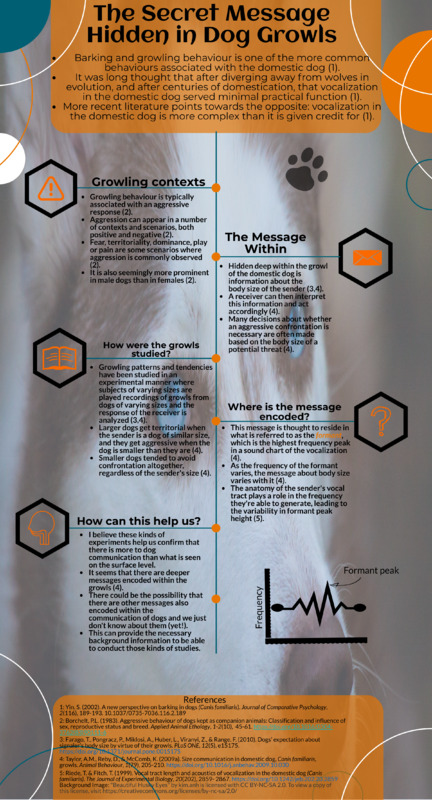The Secret Message Hidden Within Dog Growls!
Item
-
Title
The Secret Message Hidden Within Dog Growls!
-
Contributor
Infographic Template sourced from Piktochart.com, Clip Art Images sourced from Piktochart.com, Background Image: "Beautiful Husky Eyes" by kim.anh is licensed with CC BY-NC-SA 2.0. To view a copy of this license, visit https://creativecommons.org/licenses/by-nc-sa/2.0/
-
Description
A detailed infographic designed to spark curiosity and encourage people to explore a super interesting, yet vastly understudied topic about vocalization behaviour in domestic dogs!
-
References
[1]: Yin, S. (2002). A new perspective on barking in dogs (Canis familiaris). Journal of Comparative Psychology, 2(116), 189-193. 10.1037/0735-7036.116.2.189. [2]: Yin, S. & McCowan, B. (2004). Barking in domestic dogs: Context specificity and individual identification. Animal Behaviour, 2(68), 343-355. https://doi.org/10.1016/j.anbehav.2003.07.016. [3]: Riede, T. & Fitch, T. (1999). Vocal tract length and acoustics of vocalization in the domestic dog (Canis familiaris). The Journal of Experimental Biology, 20(202), 2859- 2867. https://doi.org/10.1242/jeb.202.20.2859. [4]: Farago, T., Pongracz, P., Miklosi, A., Huber, L., Viranyi, Z., & Range. F. (2010). Dogs’ expectation about signaler’s body size by virtue of their growls. PLoS ONE, 12(5), e15175. https://doi.org/10.1371/journal.pone.0015175. [5]: Taylor, A.M., Reby, D., & McComb, K. (2009a). Size communication in domestic dog, Canis familiaris, growls. Animal Behaviour, 1(79), 205-210. https://doi.org/10.1016/j.anbehav.2009.10.030. [6]: Larranaga, A., Biezla, C., Pongracz, P., Farago, T., Balint, A., & Larranaga, P. (2014). Comparing supervised learning methods for classifying sex, age, context and individual Mudi dogs from barking. Animal Cognition, 2(18), 405-421. https://doi.org/10.1007/s10071-014-0811-7. [7]: Gutierrez-Serrafin, B., Perez-Espinosa, H., Martinez-Miranda, J. & Espinosa-Cureil, I. (2019). Classification of barking context of domestic dog using high-level descriptors. Research in Computing Science, 3(148), 23-35. 10.13053/rcs-148-3-2. [8]: Pongracz, P., Molnar, C. & Miklosi, A. (2006). Acoustic parameters of dog barks carry emotional information for humans. Applied Animal Behaviour Science, 3-4(100), 228- 240. https://doi.org/10.1016/j.applanim.2005.12.004
. [9]: Pongracz, P., Molnar, C., & Miklosi, A. (2009). Barking in family dogs: An ethological approach. The Veterinary Journal, 2(183), 141-147. https://doi.org/10.1016/j.tvjl.2008.12.010. [10]: Taylor, A.M., Reby, D., & McComb, K. (2009b). Context-related variation in the vocal growling behaviour of the domestic dog (Canis familiaris). Ethology: International Journal of Behavioral Biology, 10(115), 905-915. https://doi.org/10.1111/j.1439- 0310.2009.01681.x. [11]: Borchelt, P.L. (1983). Aggressive behaviour of dogs kept as companion animals: Classification and influence of sex, reproductive status and breed. Applied Animal Ethology, 1-2(10), 45-61. https://doi.org/10.1016/0304-3762(83)90111-6. [12]: Background Image: "Beautiful Husky Eyes" by kim.anh is licensed with CC BY-NC-SA 2.0. To view a copy of this license, visit https://creativecommons.org/licenses/by-nc-sa/2.0/

